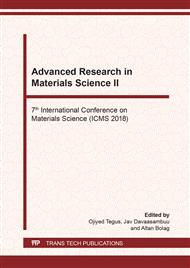[1]
M.L. Chabinyc, A. Salleo, Materials requirements and fabrication of active matrix arrays of organic thin-film transistors for displays, Chem. Mater. 16 (2004) 4509-4521.
DOI: 10.1021/cm049647z
Google Scholar
[2]
C.W. Tang, S.A. Vanslyke, Organic electroluminescent diodes, Appl. Phys. Lett. 51 (1987) 913.
DOI: 10.1063/1.98799
Google Scholar
[3]
J.H. Burroughes, D.D.C. Bradley, A.R. Brown, R.N. Marks, K. Mackay, R.H. Friend, P.L. Burns, A.B. Holmes, Light-emitting diodes based on conjugated polymers, Nature 347 (1990) 539-541.
DOI: 10.1038/347539a0
Google Scholar
[4]
C.W. Tang, Two-layer organic photovoltaic cell, Appl. Phys. Lett. 48 (1986) 183-185.
Google Scholar
[5]
H. Koezuka, A. Tsumura, T. Ando, Field-effect transistor with polythiophene thin film, Synthetic Met 18 (1987) 699–704.
DOI: 10.1016/0379-6779(87)90964-7
Google Scholar
[6]
T. Mori, Molecular materials for organic field-effect transistors, J. Phys.: Condens.Matter 20 (2008) 184010.
DOI: 10.1088/0953-8984/20/18/184010
Google Scholar
[7]
C.L. Wang, H.L. Dong, W.P. Hu, Y.Q. Liu, D.B. Zhu, Semiconducting π-conjugated systems in field-effect transistors: A material odyssey of organic electronics, Chem. Rev. 112 (2012) 2208-2267.
DOI: 10.1021/cr100380z
Google Scholar
[8]
X.K. Gao, Z. Zhao, High mobility organic semiconductors for field-effect transistors, Sci. China Chem. 58 (2015) 947-968.
DOI: 10.1007/s11426-015-5399-5
Google Scholar
[9]
M. Kitamura, Y. Arakawa, Pentacene-based organic field-effect transistors, J. Phys.: Condens. Matter. 20 (2008) 184011.
DOI: 10.1088/0953-8984/20/18/184011
Google Scholar
[10]
A.R. Murphy, J.M.J. Fréchet, Organic Semiconducting oligomers for use in thin film transistors, Chem. Rev. 107 (2007) 1066-1096.
DOI: 10.1021/cr0501386
Google Scholar
[11]
X.K. Gao, W.F. Qiu, Y.Q. Liu, G. Yu, D.B. Zhu, Organic field-effect transistors based on tetrathiafulvalene derivatives, Pure Appl. Chem. 80 (2008) 2405-2423.
DOI: 10.1351/pac200880112405
Google Scholar
[12]
A. Bolag, M. Mamada, J. Nishida, Y. Yamashita, Field-effect transistors based on tetraphenyldipyranylidenes and the sulfur analogues, Chem. Mater. 21 (2009) 4350-4352.
DOI: 10.1021/cm902037w
Google Scholar
[13]
M. Courte, M. Alaaeddine, V. Barth, L. Tortech, D. Fichou, Structural and electronic properties of 2,2',6,6'-tetraphenyldipyranylidene and its use as a hole-collecting interfacial layer in organic solar cells, Dyes Pigm. 141 (2017) 487-492.
DOI: 10.1016/j.dyepig.2017.03.002
Google Scholar
[14]
C.S.M. Courté, A.K.S. Tang, D. Fichou, Quinoidal 2,2',6,6'-tetraphenyl-dipyranylidene as a dopant-free hole-transport material for stable and cost-effective perovskite solar cells, Energy Technol. 5 (2017) 1852-1858.
DOI: 10.1002/ente.201700448
Google Scholar
[15]
C.D. Dimitrakopoulos P.R.L. Malenfant, Organic Thin Film Transistors for Large Area Electronics, Adv. Mater. 14 (2002) 99-117.
DOI: 10.1002/1521-4095(20020116)14:2<99::aid-adma99>3.0.co;2-9
Google Scholar
[16]
J. Dagar, V. Yadav, P. Tyagi, R.K. Singh, C.K. Suman, R. Srivastava, Effect of reduction of trap charge carrier density in organic field effect transistors by surface treatment of dielectric layer, J. Appl. Phys. 114 (2013) 224504.
DOI: 10.1063/1.4842856
Google Scholar


